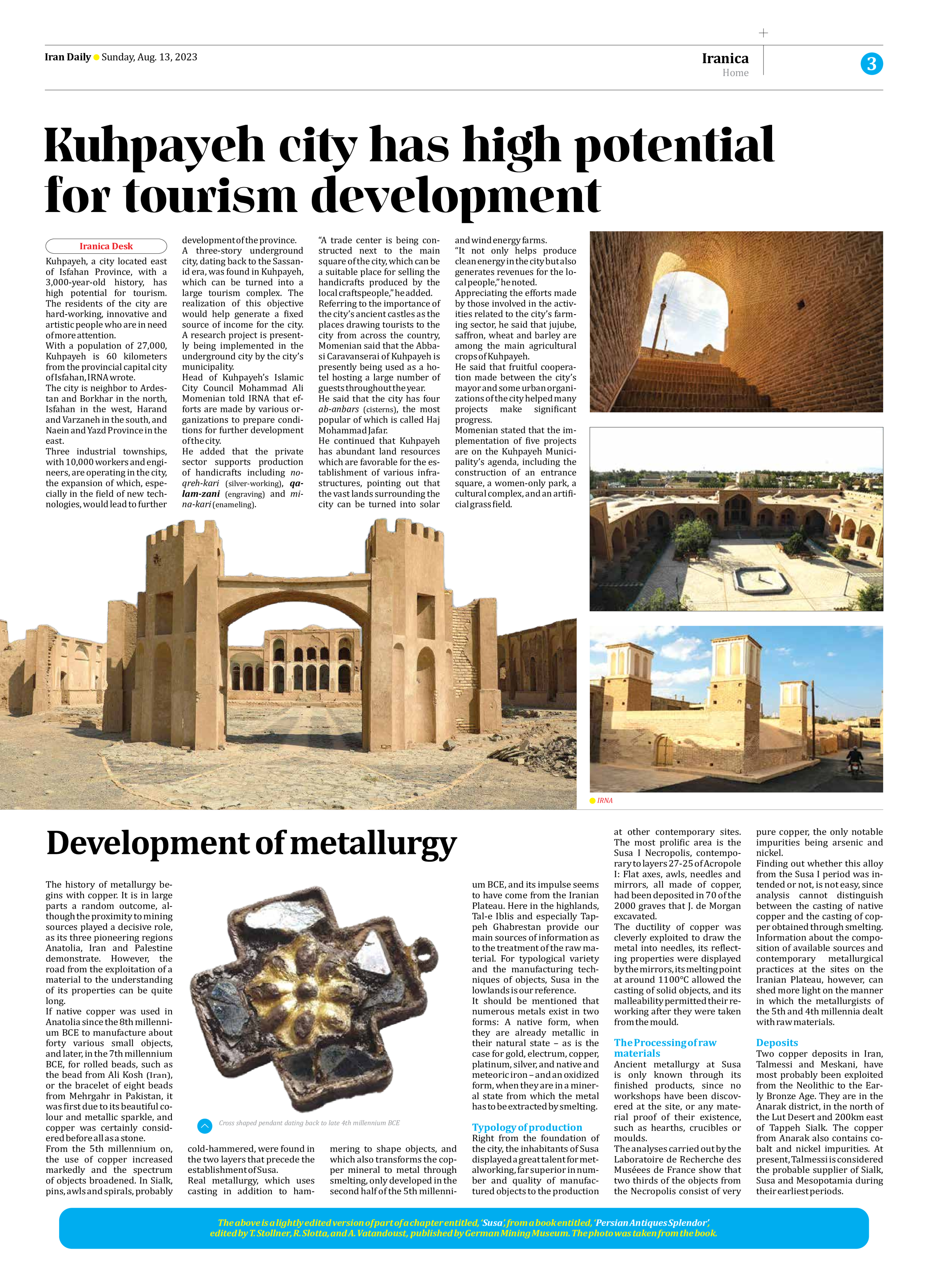
Development of metallurgy
The history of metallurgy begins with copper. It is in large parts a random outcome, although the proximity to mining sources played a decisive role, as its three pioneering regions Anatolia, Iran and Palestine demonstrate. However, the road from the exploitation of a material to the understanding of its properties can be quite long.
If native copper was used in Anatolia since the 8th millennium BCE to manufacture about forty various small objects, and later, in the 7th millennium BCE, for rolled beads, such as the bead from Ali Kosh (Iran), or the bracelet of eight beads from Mehrgahr in Pakistan, it was first due to its beautiful colour and metallic sparkle, and copper was certainly considered before all as a stone.
From the 5th millennium on, the use of copper increased markedly and the spectrum of objects broadened. In Sialk, pins, awls and spirals, probably cold-hammered, were found in the two layers that precede the establishment of Susa.
Real metallurgy, which uses casting in addition to hammering to shape objects, and which also transforms the copper mineral to metal through smelting, only developed in the second half of the 5th millennium BCE, and its impulse seems to have come from the Iranian Plateau. Here in the highlands, Tal-e Iblis and especially Tappeh Ghabrestan provide our main sources of information as to the treatment of the raw material. For typological variety and the manufacturing techniques of objects, Susa in the lowlands is our reference.
It should be mentioned that numerous metals exist in two forms: A native form, when they are already metallic in their natural state – as is the case for gold, electrum, copper, platinum, silver, and native and meteoric iron – and an oxidized form, when they are in a mineral state from which the metal has to be extracted by smelting.
Typology of production
Right from the foundation of the city, the inhabitants of Susa displayed a great talent for metalworking, far superior in number and quality of manufactured objects to the production at other contemporary sites. The most prolific area is the Susa I Necropolis, contemporary to layers 27-25 of Acropole I: Flat axes, awls, needles and mirrors, all made of copper, had been deposited in 70 of the 2000 graves that J. de Morgan excavated.
The ductility of copper was cleverly exploited to draw the metal into needles, its reflecting properties were displayed by the mirrors, its melting point at around 1100°C allowed the casting of solid objects, and its malleability permitted their reworking after they were taken from the mould.
The Processing of raw materials
Ancient metallurgy at Susa is only known through its finished products, since no workshops have been discovered at the site, or any material proof of their existence, such as hearths, crucibles or
moulds.
The analyses carried out by the Laboratoire de Recherche des Muséees de France show that two thirds of the objects from the Necropolis consist of very pure copper, the only notable impurities being arsenic and nickel.
Finding out whether this alloy from the Susa I period was intended or not, is not easy, since analysis cannot distinguish between the casting of native copper and the casting of copper obtained through smelting. Information about the composition of available sources and contemporary metallurgical practices at the sites on the Iranian Plateau, however, can shed more light on the manner in which the metallurgists of the 5th and 4th millennia dealt with raw materials.
Deposits
Two copper deposits in Iran, Talmessi and Meskani, have most probably been exploited from the Neolithic to the Early Bronze Age. They are in the Anarak district, in the north of the Lut Desert and 200km east of Tappeh Sialk. The copper from Anarak also contains cobalt and nickel impurities. At present, Talmessi is considered the probable supplier of Sialk, Susa and Mesopotamia during their earliest periods.
The above is a lightly edited version of part of a chapter entitled, ‘Susa’, from a book entitled, ‘Persian Antiques Splendor’,
edited by T. Stollner, R. Slotta, and A. Vatandoust, published by German Mining Museum. The photo was taken from the book.







